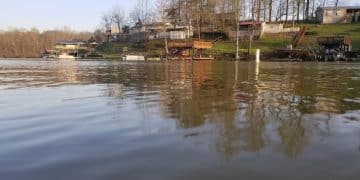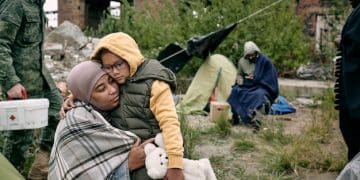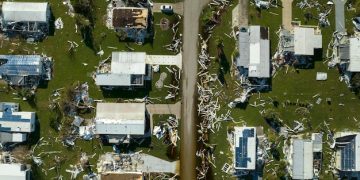International Aid: Climate Change Mitigation in US Vulnerable Communities
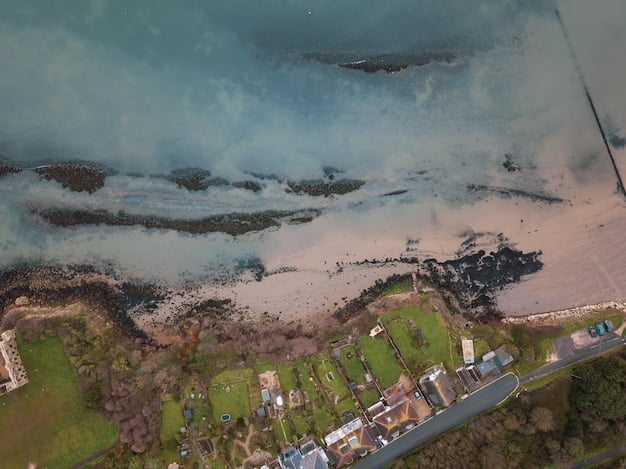
International aid organizations play a crucial role in supporting vulnerable communities in the US that are disproportionately affected by climate change impacts by providing resources, expertise, and funding for adaptation and mitigation efforts.
Understanding the role of international aid organizations in addressing climate change impacts in vulnerable US communities is increasingly important as these communities face escalating environmental challenges. These organizations provide crucial support, filling gaps in local and national efforts to mitigate and adapt to the effects of climate change.
The Rising Urgency of Climate Action in the US
Climate change is no longer a distant threat; it’s a present reality, particularly for vulnerable communities across the United States. These communities, often characterized by socioeconomic challenges and limited resources, face heightened risks from extreme weather events, rising sea levels, and other climate-related disasters.
Addressing these challenges requires a multi-faceted approach, and international aid organizations are playing an increasingly important role in providing critical assistance.
Vulnerable Communities: A Closer Look
Vulnerable communities in the US include coastal regions susceptible to flooding, low-income neighborhoods facing environmental injustice, and rural areas heavily reliant on agriculture. These areas often lack the infrastructure and resources needed to withstand and recover from climate change impacts.
- Coastal regions: Face threats from rising sea levels, erosion, and increased storm surges.
- Low-income neighborhoods: Often located near industrial sites, exacerbating health issues related to pollution.
- Rural areas: Dependent on agriculture, struggling with drought, wildfires, and changing growing seasons.
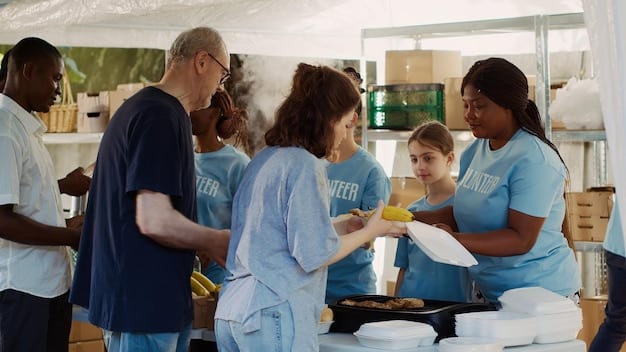
The vulnerability of these communities is compounded by systemic inequalities, making them disproportionately affected. International aid organizations are uniquely positioned to help bridge these gaps.
The Role of International Aid Organizations
International aid organizations bring expertise, resources, and funding to support climate resilience and adaptation efforts in vulnerable US communities. Their involvement spans a wide range of activities, from disaster relief and infrastructure development to community education and policy advocacy.
These organizations often operate with a global perspective, leveraging best practices. This helps in implementing effective strategies to combat the impacts of climate change.
Expertise and Resources
International aid organizations provide technical expertise in areas. This includes climate modeling, risk management, and sustainable development. They also offer financial support, funding projects aimed at reducing greenhouse gas emissions.
- Technical assistance: Sharing knowledge and skills to improve resilience and sustainability.
- Financial support: Providing grants and loans to fund climate-related projects.
- Capacity building: Training and empowering local communities to address climate challenges.
By offering these resources, international aid organizations help to bolster the capacity of vulnerable communities.
Specific Climate Change Impacts Addressed
Climate change manifests in various ways across the US, and international aid organizations are actively involved in addressing specific impacts. These include extreme weather events, water scarcity, and food insecurity, each requiring tailored interventions and support.
These impacts not only threaten the environment but also exacerbate social and economic inequalities, making the role of international aid even more critical.

Extreme Weather Events: Disaster Relief and Preparedness
The increasing frequency and intensity of hurricanes, floods, and wildfires necessitate robust disaster relief and preparedness measures. International aid organizations provide emergency assistance, funding relief efforts, and supporting long-term recovery projects.
International aid organizations often work in tandem with local authorities and community organizations, ensuring that aid reaches those who need it most.
Challenges and Opportunities
Despite their significant contributions, international aid organizations face numerous challenges in addressing climate change impacts in vulnerable US communities. These challenges include bureaucratic hurdles, funding constraints, and coordination complexities.
Overcoming these obstacles requires innovative solutions, collaborative partnerships, and a commitment to long-term engagement.
Coordination and Collaboration
Effective coordination among international aid organizations, government agencies, and local stakeholders is essential for maximizing impact. Clear communication channels, shared goals, and collaborative planning can help streamline efforts and avoid duplication.
- Streamlined communication: Ensuring that all stakeholders are informed and aligned.
- Shared goals: Working towards common objectives to achieve greater impact.
- Collaborative planning: Developing coordinated strategies to address climate challenges.
Addressing these constraints demands strategic planning, resource mobilization, and a focus on building long-term resilience within vulnerable communities.
Case Studies: Successful Interventions
Several case studies highlight the positive impact of international aid organizations in addressing climate change impacts in vulnerable US communities. These examples demonstrate the effectiveness of targeted interventions and collaborative partnerships.
These case studies provide valuable lessons and insights for future initiatives, showcasing the potential for international aid to drive meaningful change.
To provide real world context, here are three specific examples:
Coastal Restoration in Louisiana
Organizations involved have supported initiatives to restore coastal wetlands, which act as natural barriers to storm surges. These efforts involve planting native vegetation, reinforcing shorelines, and implementing sustainable land management practices.
Urban Resilience in New York City
After Superstorm Sandy, funding was provided by international organizations. These funds supported infrastructure improvements, such as strengthening seawalls, upgrading drainage systems, and enhancing emergency response capabilities in vulnerable neighborhoods.
Drought Resilience in California
In drought-stricken regions, various organizations worked with local farmers to implement water-efficient irrigation systems, promote drought-resistant crops, and provide training on water conservation techniques.
The Future of International Aid and Climate Resilience
The future of international aid in addressing climate change depends on continued commitment, innovation, and collaboration. As climate risks intensify, the role of these organizations will become even more critical in supporting vulnerable US communities.
Embracing a proactive and forward-looking approach will enable international aid organizations to effectively contribute to a more resilient and sustainable future for all.
| Key Point | Brief Description |
|---|---|
| 🌍 Climate Change Vulnerability | US communities face increasing climate risks. |
| 🤝 International Aid Role | Organizations provide expertise & resources. |
| 🌊 Disaster Relief | Support for extreme weather events. |
| 🌱 Future Resilience | Continued innovation crucial for US. |
Frequently Asked Questions
The US faces increasing challenges. These include extreme weather events like hurricanes, floods, droughts and wildfires. Vulnerable communities bear the brunt of related impacts.
These organizations offer expertise, funding, and technology. These help local communities in climate change adaptation and mitigation projects. They provide training and resources.
Communities can improve coordination. This can be done by maintaining clear communication channels, sharing data. By setting common goals with aid organizations they will streamline response efforts.
Examples include Louisiana coastal restoration and resilient infrastructure in NYC. Also, there’s the drought resilience measures in California. These showcase effective intervention strategies.
By fostering innovation, enhancing data transparency, and promoting climate-resilient development international can adapt. Ensuring equitable access this will enhance aid’s long-term effectiveness.
Conclusion
In conclusion, understanding the role of international aid organizations in addressing climate change impacts in vulnerable US communities is critical for fostering resilience. These organizations provide vital resources, expertise, and support, helping communities adapt to climate change effects. With continued commitment, collaboration, and innovation, international aid can play a pivotal role in securing a sustainable future for all.
